ADDIS ABABA, Ethiopia (AP) ŌĆö Forces from EthiopiaŌĆÖs Amhara region have displaced tens of thousands of ethnic Tigrayans from disputed territory in the north of the country in recent weeks despite a , according to aid workers and internal agency documents seen by the AP.
The in northwestern Tigray is close to the regional border with Amhara. It changed hands several times during the war, which erupted in 2020 and ended with a ceasefire in November. The Amhara people claim the area as their own.
Since early March, some 47,000 people uprooted from Mai Tsebri have gone to Endabaguna, a town roughly 55 kilometers (34 miles) further north, according to United Nations figures seen by the AP on Thursday.
Another report, prepared by a humanitarian agency, says residents fled Mai Tsebri because of ŌĆ£harassment, ethnic profiling and direct threatsŌĆØ from irregular Amhara forces that also carried out ŌĆ£evictions.ŌĆØ
That report adds that there have been no aid deliveries to Endabaguna since the displaced people started arriving. As a result, it says, they are ŌĆ£on the brink of starvation.ŌĆØ
The displaced people at Endabaguna are sheltering in a reception center originally built by the U.N. and EthiopiaŌĆÖs government for refugees from Eritrea, which borders Tigray. The site was badly damaged during the war.
An aid worker who recently visited the center said conditions there were ŌĆ£very badŌĆØ and the number of people was ŌĆ£increasing day by day.ŌĆØ
ŌĆ£The roofing and pipelines are damaged, there is no toilet and latrine, the doors and windows of the rooms are looted (or) damaged, and there is no proper water supply,ŌĆØ said the aid worker, who requested anonymity because of the sensitivity of the matter.
It was not immediately possible to get a comment from Amhara authorities.
A second aid worker, who also requested anonymity because they were not authorized to speak to a reporter, said many of the people recently uprooted from Mai Tsebri were displaced for a second time, having already been forced from their homes in the western part of Tigray.
Amhara forces annexed western Tigray in the early stages of the war. They stand accused of ŌĆ£ethnic cleansingŌĆØ by the U.S. State Department after they forcibly deported hundreds of thousands of Tigrayans from the area.
Under the recent ceasefire, aid deliveries to Tigray resumed after two years of restrictions. However, aid workers say Amhara forces have continued to block food distribution around Mai Tsebri, and residents have reported killings.
One Mai Tsebri resident, Teferi Muley, said he fled the area in November after he was threatened by Amhara troops, who accused him of helping the Tigray rebels. He said he returned in March to the nearby village of Haida, where he witnessed the shooting of several artisanal gold miners by Amhara troops.
Last week EthiopiaŌĆÖs government said it planned to fold the security forces of the 11 federal regions into the national army or police. This prompted a wave of protest across Amhara, as well as gun battles between the federal military and regional Amhara units who refused to disarm.
Humanitarian officials believe the upheaval will likely lead to an increase in displacements from Mai Tsebri, which already stand at an average of 150 households every day, according to an assessment by another aid agency.
The Associated Press



